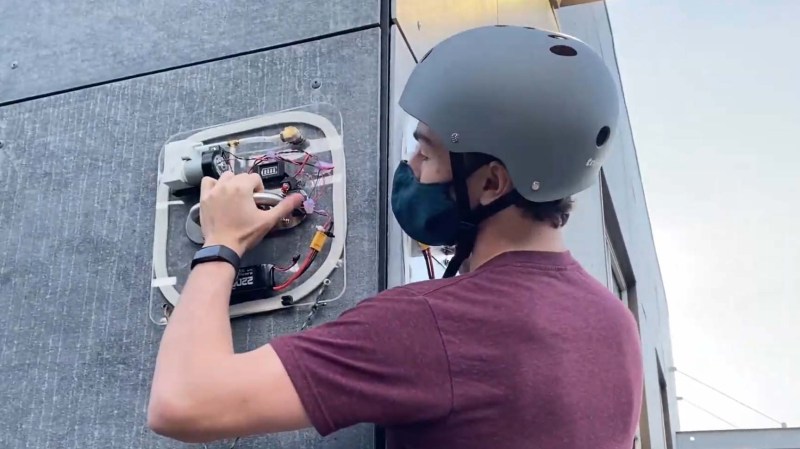Walls can’t hold [Elijah Cirioli]. The would-be superhero has been busy scaling the sides of buildings using his self-contained vacuum climbers. (Video embedded after the break.)
After being inspired by the winning project of an Air Force design challenge, our plain-clothed crusader got to work on a pair of prototype vacuum climbers. The wooden prototypes were an unexpected success, so work soon began on the models featured in the video after the break. The main improvements in this second version included using ¼ inch acrylic instead of plywood, as well as an improved gasket for a better seal against the imperfect exterior of many building walls.
While the system would still ultimately struggle with brick walls (and other imperfect surfaces), it performs more than adequately when ascending smoother concrete walls. And while the acrylic was a far better choice than the plywood, one of the acrylic panels still developed a fracture. Even so, the results speak for themselves, and we have to applaud the inventor’s seemingly unconditional trust in his equipment.
We haven’t seen a follow-up from [Elijah Cirioli] recently, so here’s hoping that he’s busy working on version three, and that he’s not stuck up a wall somewhere. In the meantime, check out how someone accomplished similar wall-climbing feats using salvaged microwave transformers.
[Many thanks to mike cirioli for the tip]
















https://en.wikipedia.org/wiki/Prowler_(Marvel_Comics)#Hobie_Brown Literally superhero tier. Awesome.
Hellspawn level… https://spawn.fandom.com/wiki/Hellspawn
So take my supervillainy to the top of wooden towers to defeat magnet climbing man too, got it.
stucco cladding and you get bonus points for making it out of Asbestos.
That needs WAY more redundancy, it’s a critical life support system as soon as you’re more than a body length or two above ground… he should probably carry one or two complete spares with him in case the seal becomes damaged or there is a malfunction. I mean, the safety advice for cave exploration is to carry three sources of light per person, and in most caves the only result of a party running out of light is being stuck until they are found (assuming they remembered to tell someone when to come look for them.)
Fully agree: each “suck” should have two different vacuum zones with independent gaskets and vacuum pumps, and four electrovalves in each zone, in series-parallel configuration to ensure that it will work no matter if one gets stuck opened or closed.
Same goes for the mask, make sure to bring spares in case your second one blows off in the wind.
Very cool. However, natural surface grabbing systems are all decentralized because it’s more robust. A single failure here results in total system failure which in this case can be lethal.
Even with more redundancy, when he is moving one of the pads, his whole weight must be supported by the other one, and if there is a catastrophic failure, he could easily fall to his death.
Please just rig up a belay system with a climbing harness and dynamic rope and a partner with belay experience, like wall climbers do.
On the top of the redundancy well explained in the aforementioned comments, having two more suction devices attached to the feet would better displace the weight to a minimum of two, possibly speeding up a bit the climb (ex: pushing the button on the left hand device would trigger the one on the right foot symmetrically).
Or attached to the knees.
‘Baltic” plywood maybe but the plastic that cracks like glass with your load bearing on holes drilled into the plastic, yikes!
Perhaps that transparent aluminum would be best. I agree acrylic is terrifying. If he’s not afraid of it, it’s because he hasn’t used it enough.
Been done https://youtu.be/DVbamP0ED10
Very cool project. Even if I’m already sweating because of the height and lack of protection. I find it amazing how compact the vacuum holder plates are and how little space you need for the technology.
Good to see that he’s wearing his face mask. Wouldn’t want to be taking any unnecessary risks.
The mask is not for him. It’s to protect the people he cares about.
If he cared about them, he wouldn’t be posting his real name, and face, all over the Internet, for any villain to find.
Hey, it’s Gordon Gecko!
1++
Super cool!
Acrylic? Dude! Get some polycarbonate!
+1!!!
Great! It reminds me this show episode (french): https://youtu.be/K7PivuAFzrc?t=800
My thoughts exactly, if it MUST be transparent, at the very least use PC. Acrylic is NOT a suitable load bearing material with any reliable strength.
I don’t get the diss of wood in the article. Wood is not such a terrible material as some people make it out to be.
Why did my reply to mrehorst become it’s own post?
Probably because you’re blocking some of the cookies/Javascript that WordPress JetPack uses to align comments with their parents. (I don’t actually know which it is, and it’s unfortunately out of our control anyway.)
Combine it with gecko pads:
https://www.livescience.com/48845-gecko-inspired-tech-climbing-walls.html
Mythbusters did it in one of their episodes.
Here’s one you can buy right now.
https://grabo.com/